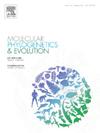非洲热带特有的 Nomiinae 属 Trinomia(膜翅目:Halictidae)的系统发育、古老性和生态位占有。
IF 3.6
1区 生物学
Q2 BIOCHEMISTRY & MOLECULAR BIOLOGY
引用次数: 0
摘要
非洲热带地区是许多地方性蜂群的家园,但几乎没有一个从综合、整体的角度进行过研究。其中,halictid Nomiinae亚科具有独特的非洲多样性,其分布和生活史各异。在这里,我们结合系统基因组学、分子测年和分布模型来探索Trinomia属的进化生态学。利用超保守元件(UCE)和全基因组数据分析了59种triniinae属(包括所有6种Trinomia)的矩阵,并估计了该亚科的分化时间。利用最大熵模型(MaxEnt)和671个空间数据点建立了6种三棱藓属植物的分布模型。从这些方法中,我们发现了一种单系的Trinomia,它与亚洲特有的Gnathonomia属有着意想不到的姐妹群关系,并且在中新世晚期(~ 580万年前)发现了Trinomia的起源。从我们的研究结果中,我们发现了Trinomia姐妹群体分布的系统发育保守性,然而,我们的研究结果也强调了对非洲蜜蜂进行额外的调查、鉴定和共享数据的必要性。本研究代表了非洲特有蜜蜂空间系统基因组学研究的典范性第一步。本文章由计算机程序翻译,如有差异,请以英文原文为准。

Phylogeny, antiquity, and niche occupancy of Trinomia (Hymenoptera: Halictidae), an Afrotropical endemic genus of Nomiinae
The Afrotropical region is home to many endemic bee groups, yet almost none have been studied from an integrated, holistic perspective. Among them, the halictid subfamily Nomiinae contains exceptional African diversity with variable distributions and life histories. Here, we combine phylogenomics, molecular dating, and distributional modelling to explore the evolutionary ecology of the genus Trinomia. We analyzed a matrix of 59 species of Nomiinae using ultraconserved element (UCE) and whole genome data, including all six species of Trinomia, and estimated divergence times for the subfamily. We then generated distribution models for all six species of Trinomia using Maximum Entropy models (MaxEnt) and 671 spatial data points. From these methods, we discovered a monophyletic Trinomia with an unexpected sister group relationship to the Asian-endemic genus Gnathonomia, as well as a recent origin of Trinomia in the late Miocene (∼5.8 million years ago). From our results, we found hints of phylogenetic conservatism in distribution among sister-groups of Trinomia, however, our results also highlight the need for additional efforts inventorying, identifying, and sharing data on African bees. This study represents an exemplary first step into studying bee spatial phylogenomics of African endemic bees.
求助全文
通过发布文献求助,成功后即可免费获取论文全文。
去求助
来源期刊
CiteScore
7.50
自引率
7.30%
发文量
249
审稿时长
7.5 months
期刊介绍:
Molecular Phylogenetics and Evolution is dedicated to bringing Darwin''s dream within grasp - to "have fairly true genealogical trees of each great kingdom of Nature." The journal provides a forum for molecular studies that advance our understanding of phylogeny and evolution, further the development of phylogenetically more accurate taxonomic classifications, and ultimately bring a unified classification for all the ramifying lines of life. Phylogeographic studies will be considered for publication if they offer EXCEPTIONAL theoretical or empirical advances.

 求助内容:
求助内容: 应助结果提醒方式:
应助结果提醒方式:


